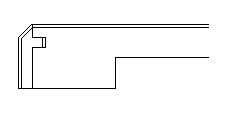 Design Watch: Laminate:When applying any edge to the front of a countertop, be advised that a water "channel" may be created at the join of the two products. Some edges, like the SSV and Gibraltar applied edges use a better adhesive that extends up to the deck, but you are still "sticking" something on. Make sure that the customer knows not to drape wet towels over the front, or allow any significant wetness to apply. Solid Surface:There is not a significant amount of danger ion applying a decorative edge to solid surface. The best material to apply is the material itself in a different color or pattern. Tile can be applied, wood, metal, etc. All of these elements result in increasing the maintenance of a low maintenance product. If another material is to be applied, a sandwich inlay is technically the best way to go. Applications: Primarily decorative, applied edges can introduce features and patterns into a plain edge, blending the countertop with other elements in the environment. Laminate, in particular, benefits as the black line is eliminated, while a feature stripe is introduced. |
Other Terms: Bevel edge, Solid edge, Splayed edge, SSV edge Description: Laminate: a moulding is applied to a routed counter front for decorative effect. This material can be laminated mouldings, like bevel edges; "executive edges", where a flat laminate top layer acts as a border over a standard bevel; metal, wood, solid surface, or solid surface veneer, tile, etc. Solid Surface: Many materials can be applied to the front of a solid surface countertop. Most will be there only for effect, not for any technical advantage. The best material to apply is a different color of the same product. Variations:Many companies, including Mather, has equipment that can route a bevel into a self edge laminate countertop, allowing a strip of laminate to be inlaid, thus providing a better protected edge for the top.(see "design watch")
|